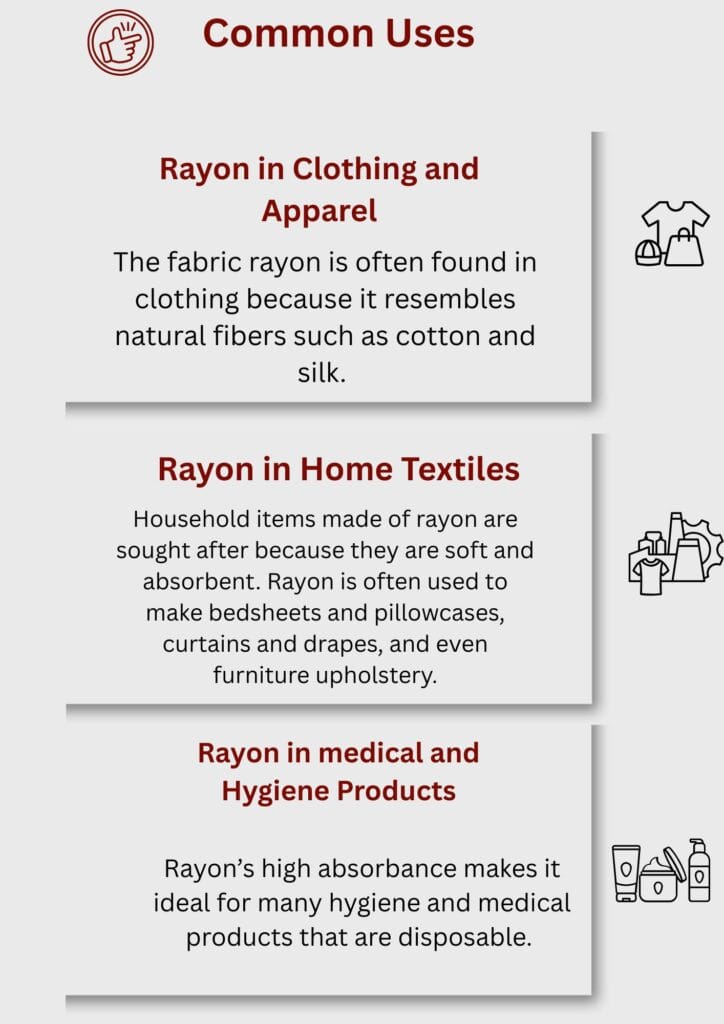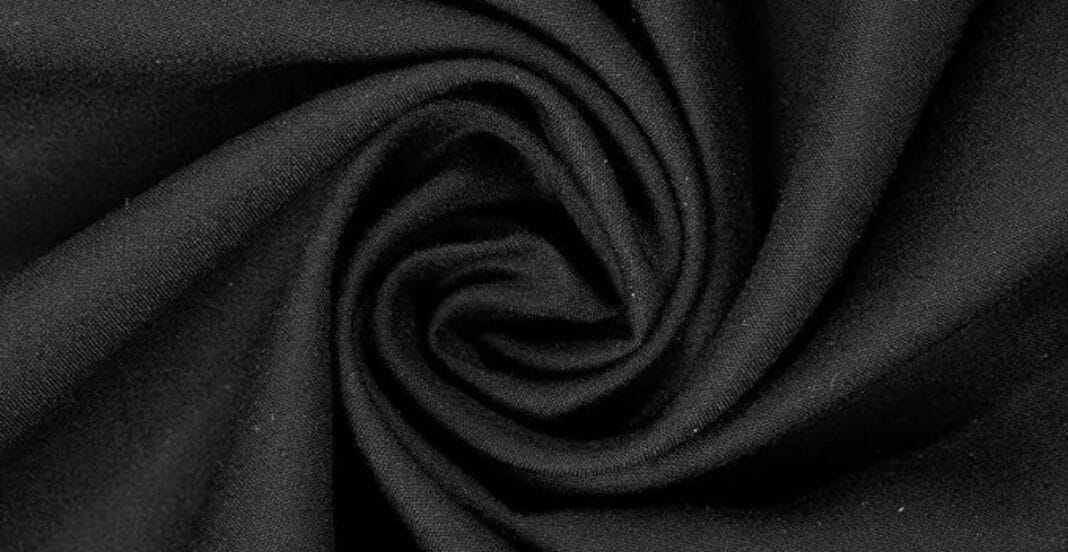Introduction
Rayon fabric is semi-synthetic fiber deriving from natural cellulose, most often wood pulp. It’s hybrid in nature because, although it is sourced from nature, significant chemical processing is required to change it into fiber. So, in rayon’s case, it is situated in our classification between natural and synthetic fabrics.
Due to its softness, breathability, and silk-like texture, rayon has become a staple in the fashion industry and is also found in home textiles such as curtains and bedsheets, as well as in medical supplies like bandages. Indeed, its versatility and low cost has led to global proliferation.
However, with the popularization of protective masks and other medical-grade equipment, concerns radioactive masks, chemical-grade protective clothing, and the fabrics that constitute them has also surfaced. Is it safe to wear, or breath rayon? This article aims to provide comprehensive answers, from its production process to potential danger claims regarding our health and the ecosystem.
How Rayon Is Made: A Chemical Transformation
Rayon is formed with a method called viscose process, due to its in-depth chemical treatment. This method involves the treatment of wood pulp cellulose with sodium hydroxide, which is then treated with carbon disulfide to form viscous solution. This solution is forced through spinnerets into a sulfuric acid bath which in turn, solidifies the fiber.
Although effective in producing soft and flexible fabrics, some of the chemicals used in this process are troubling. For example, carbon disulfide is harmful to both animals and humans. For workers, the exposure can lead to neurological dysfunction, reproduction complications, and even cardiovascular issues.
The good news is that newer approaches like lyocell (Tencel) and modal utilize closed-loop systems that capture and recycle almost all solvents. While these fabrics are considered to be gentler and more environmentally responsible, they are still technically forms of rayon.
Is Rayon Toxic to Wear? Health Effects on Skin
A lot of people ask is rayon could lead to any health complications. For the average person, rayon should not be harmful to wear. But people with hypersensitive skin and allergy issues may be susceptible to some degree of discomfort, particularly in warmer and more humid environments when wearing rayon.
Compared to the more natural cotton and linen fabrics, rayon is less breathable and can suffocate the skin. But, rayon is still more comfortable than purely polyester or nylon garments, which are synthetic and less allow any ventilation.
It is also important to remember that fabrics made from rayon may be treated with formaldehyde resins to diminish wrinkles. Considering that formaldehyde is an irritant and possible carcinogen, it is important to purchase untreated or certified-safe products.
Is Rayon Toxic to Breathe? Risks for Workers and Consumers
The inhalation hazards associated rayon mostly depend on the situation. Workers in rayon producing factories have the highest hazards. Breathing carbon disulfide vapors can damage the skeletal and central nervous systems, cause vision problems, and disrupt the endocrine systems.
The risk for consumers is substantially reduced. The risk of wearing rayon clothing is minimal, and for the off-gassing, the risk is mostly ‘zero’. Poorly manufactured garments can still off-gas. Rayon is less toxic than polyester and vinyl, but still, emits some number of VOCs.
Common Uses

Rayon in Clothing and Apparel
The fabric rayon is often found in clothing because it resembles natural fibers such as cotton and silk. Its smooth and flowy texture makes it ideal for stylish dresses and skirts as well as blouses. Rayon is popular in summer outfits and is used in activewear and undergarments. It is also used in the lining of suits and jackets.
Because these garments are worn next to the body, there is concern about irritation to the skin, especially in cases where the fabric has been treated or dyed.
Rayon in Home Textiles
Household items made of rayon are sought after because they are soft and absorbent. Rayon is often used to make bedsheets and pillowcases, curtains and drapes, and even furniture upholstery. It is also used in decorative fabrics such as tablecloths and napkins.
However, as with other textiles, rayon fabrics used in the home may add to indoor pollution by off-gassing harmful chemicals, especially when treated with wrinkle or stain guard.
Rayon in medical and Hygiene Products
Rayon’s high absorbance makes it ideal for many hygiene and medical products that are disposable. It is used to make bandages, gauze, surgical dressings, and even in tampons and pads. These items need to be made from soft materials that absorb moisture quickly and are gentle to the skin.
Due to the intimate nature of some products and the open wounds of others, the use of rayon raises a critical safety concern due to the chemical residues it may leave behind.
The use of rayon in industrial applications
Aside from clothing and home textiles, rayon finds its applications in industrial areas as well. It is used in the reinforcing cords of some tires, as well as in conveyor belts, linings of some fire hoses and filtration fabrics. These fabrics take advantage of the strength, extensibility, and the wear and tear resistance of rayon.
However, the rayon industrial processes can discharge poison gasses and toxic wastewater, endangering the health of workers in those factories as well as the surrounding ecosystems.
Is Rayon Toxic to Breathe? Risks for Workers and Consumers
Based on the environmental risk of rayon, a person incurs little to no risk wearing rayon, but the hazards to populations living near rayon factories without the appropriate protective equipment can be severe.
Rayon is produced from cellulose, wood, or plant is the base constituent, but the process incurs high environmental costs. To get plant cellulose, you need to unlock the core processor. That almost always leads to illegal or unregulated logging.
The cheaper logging associated of gaining wood requires a lot of harsh chemicals. Unregulated logging can lead to the pollution of rivers and soil, which can, in turn, kill the fauna and flora.
Synthetic fabrics that take centuries to break down do not biodegrade like rayon does, which is a positive aspect. However, from a sustainability angle, the toxic methods employed to make rayon reduce its offset biodegradability.
Is Rayon Carcinogenic? Evaluating Cancer Risks
The investigation around rayon’s potential to cause cancer is still ongoing. Formaldehyde and carbon disulfide, two chemicals incorporated in its production, are known to be harmful. While no credible research directly associates the fabric with cancer, consumption and high levels of exposure to the other chemicals do pose a risk.
Despite posing an imminent risk to personal safety, rayon does not pose a long-term threat to the environment like polyester does with its microplastic shedding. The lack of safety measures, especially during production, exposes workers to high levels of peril that should not be downplayed.
Without a doubt, rayon has not been marked as a carcinogenic. Still, the chemicals employed in its manufacturing tarnish the fabric’s reputation in terms of public and private well-being.
More Secure Substitutes For Rayon Fabrics: What Are The Alternatives
For those seeking sustainable or less harmful fabrics, alternatives do exist and are processes with lower environmental impact. Organic cotton, hemp, and Tencel (lyocell) exemplifies fabrics which are processed with less chemicals, are stronger, and last longer.
Read more: Further Health Benefits of Organic Clothes.
Bamboo linen is another sustainable option, but as with everything, caution is necessary. The majority of “bamboo” fabrics such as bamboo rayon are created through a viscose-type procedure, thus, do look for labels which say mechanically processed bamboo for an environmentally friendly option.
Read more: How is Bamboo Fabric Made?
Guidelines such as Oeko-Tex Standard 100 or GOTS (Global Organic Textile Standard) can help mark fabrics as safe and made under proper regulations.
Practical Tips to Stay Safe When Using Rayon

Wash New Rayon Clothes Before Wearing
Rayon new garments are rigorously treated with formaldehydes and dyes, and thus hold left over chemicals from the manufacturing process. Skin irritation and finishing chemicals ranging from mild to moderate can be removed through washing. To maintain the shape and the softness of the garment, air drying and mild detergent coupled with cold water while washing is essential.
Buy Rayon from Transparent and Ethical Brands
Seek brands that are willing to share the information regarding the fabrics that are used and the production details. Ethical brands are likely to use cleaner types of rayon such as lyocell (Tencel) or modal, produced through safer closed-loop systems. تسio d202h219 Transparent brands tend to provide better quality, alongside trustworthy claims regarding a minimal risk on health and the environment.
Limit Rayon Use in Hot or Humid Weather
Look for the certifications of the fabrics that are issued from independent bodies which can guarantee the fabric to be safe and sustainable. Oeko-Tex Standard 100 ensures the fabric does not have harmful substances. GOTS certifies the presence of organic fiber content and safe processing of the content. FSC certified the responsible sourcing of wood pulp used in rayon for the Duit.
Avoid Cheap Quality Rayon
Cheap rayon clothes often do not meet the safety standards and could have higher toxic residue than safety precautions
Inexpensive rayon clothing could be low quality and not well crafted, allowing for easy tear, shrinkage, and the release of harmful organic compounds. Volatile organic compounds (VOCs) for example. Increasing your budget on clothing might help you lower your environmental impact.
Try to avoid wearing rayon during hot and humid days.
Wearing rayon in hot weather is not advisable due to the high chance of skin irritations, rashes, and even fungal infections. Better alternatives to rayon include cotton or linen which are both breathable and loose fitting.
Reducing Health Risks When Wearing Rayon Fabrics
Taking precautions can be difficult, especially with garments made out of rayon, but these ticks can help with reducing risks. Prior to wearing, always wash rayon clothing as this removes surface chemicals and for those with delicate skin, this helps with skin irritation.
Purchase clothing from vetted and trusted brands which use certified fabrics as this promotes proper manufacturing and clothing quality. Transparency in manufacturing often means better quality and safer products.
As previously stated, last-minute purchases from fast-fashion retailers are a big no, particularly for rayon. Such goods are often deeply neglected during manufacturing processes, putting you at a higher risk of certain health issues.
Busting Common Myths About Rayon Toxicity
Let’s take a look at some of the myths explaining the misinformation about rayon toxicity:
“Rayon is natural and completely safe.”
Rayon is made from natural cellulose, but the shredding method, as well as the mixture of certain chemicals involved, adds the risk of toxicity.
“All bamboo fabric is eco-friendly.”
Not true. Most bamboo fabric on the market is chemically processed bamboo rayon, which is no greener than regular viscose.
“Rayon is better than polyester.”
This depends. Though rayon is biodegradable, it has a higher chemical exposure level during production than polyester.
“Only synthetic fabrics are toxic.”
Natural-origin fabrics such as rayon can be equally harmful through the processes involved in manufacturing.
This is essential, for understanding the big picture can lead to better and safer decisions.
Conclusion
Therefore, the straight answer to whether rayon can be deemed as toxic or not is ambiguous.
- The answer is no, as long as the fabric comes from trusted brands and gets a proper wash prior to wearing, health risks are minute.
- The chemicals rayon diposes can be quite harmful for both the environment and manufacturing workers.
- Modal and lyocell are far greener and much less toxic alternatives.
- For health and comfort, along with having eco-friendly properties, organic cotton, Tencel, and hemp are great considerations. Checking for Oeko-Tex or GOTS certificates is always a good idea.
Empowered with the right information, a conscious decision makes it easy for people to have a wide variety of clothing which is stylish, comfortable, and safe for the planet.


